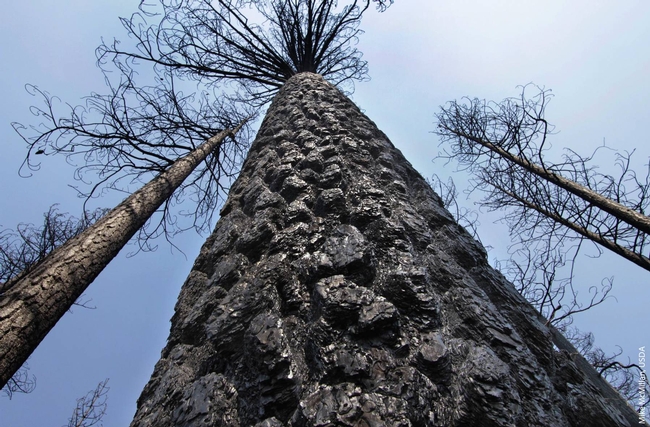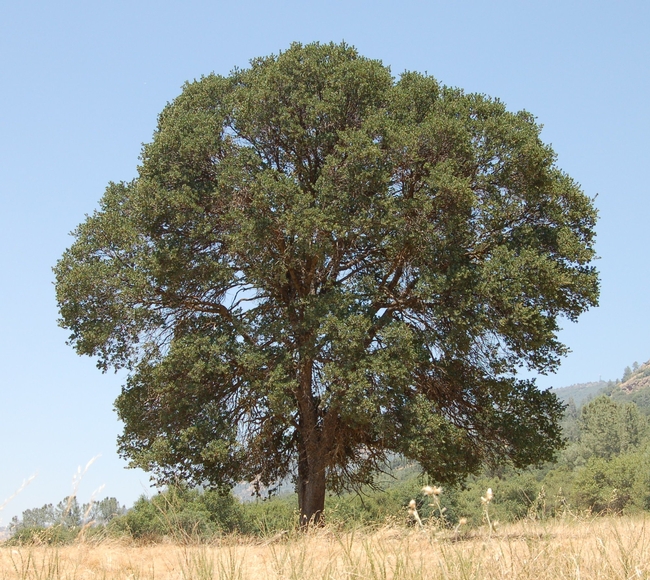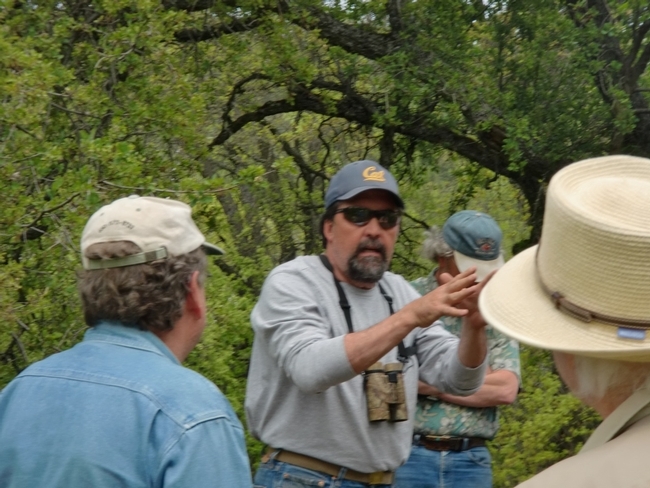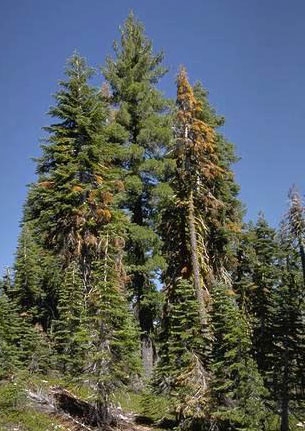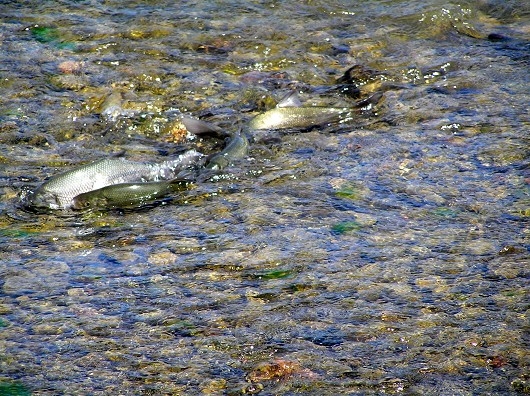Posts Tagged: Greg Giusti
Burned forestland needs erosion protection
“The loosened soil and ash can move quickly under proper storm conditions,” said Greg Giusti, a UC ANR Cooperative Extension forestry advisor. “Property owners should take immediate action.”
A longstanding practice in the West has been spreading grass seed after a fire, however, the seed is slow to germinate and grow during the cold months that follow fire season.
“Seeding is generally ineffective,” Giusti said. “The seed simply moves and erodes with the soil and ash following an initial rain event.”
After losing a home, homeowners may feel the need to clean up their property. However, leaving woody debris, downed trees and limbs will arrest soil movement. Stumps and standing dead trees also help protect the soil.
“The roots are still in the soil and will help hold it in place,” Giusti said. “As long as they don't pose a danger, trees should be left in place.”
Spreading rice straw or weed-free hay on the ground is another way to protect the soil from erosion. Whole bales of hay can be placed in natural drainages to slow water movement and reduce erosion. Straw wattles – long tubes of compressed straw encased in jute or another material – may be laid out across a slope and secured with stakes.
“I suggest landowners focus on areas of their property where they can have the greatest positive effect,” Giusti said. “You can't cover a whole hillside with straw. People can only do what they can do.”
An initiative to maintain and enhance sustainable natural ecosystems is part of UC Agriculture and Natural Resources Strategic Vision 2025.
Give oaks water once a month
Even though California's majestic oak trees are generally considered drought tolerant, the last four years of well-below-average rainfall are taking a toll, reported the Sierra Sun Times.
"In some parts of the state, oaks are being deprived of water for as long as nine months, creating extreme water stress," said Greg Giusti, a forest and wildlands advisor for UC Agriculture and Natural Resources. Giusti is headquartered in the UC ANR Cooperative Extension office in Mendocino County.
Giusti and Kris Randal, the UC Master Gardener coordinator for Mariposa County, suggest that California residents with oaks on their property give the trees a good soaking once a month during the summer.
The water should be applied around the drip line - the area below the outstretched branches - but not near the trunk. A permeable soaker hose is an ideal tool for slow application over the wide area. Allow the water to run until it has soaked down to a depth of 12 to 18 inches, which can be detected with a long probe such as a screwdriver. "If it comes up with signs of moisture at the tip, you're good," the article says.
Randal said it is important to let the soil dry out completely between waterings, because oaks are susceptible to root fungus that can grow in warm, damp soil.
Even if water is unavailable and the leaves begin to turn brown or fall, the experts suggest waiting for spring before considering removing the tree.
"If you tree leafs out, it's still alive," Randall said. "And in this drought, give it extra time to leaf out."
Rocky Fire is raging through bone dry chaparral shrublands
Northern California's Rocky Fire is roaring through shrublands that have no previous recorded history of wildfires, reported Kirk Siegler on All Things Considered. It has already burned 65,000 acres and is 12 percent contained, according to CalFire's Incident Report.
The area has been protected from fire for decades, primed for the type of catastrophic blaze California officials have been predicting.
Siegler spoke to UC Agriculture and Natural Resources Cooperative Extension wildland and forestry advisor Greg Giusti.
"We've got miles and miles of contiguous chaparral vegetation and literally there are no breaks in the vegetation," Giusti said. "It's extremely steep and, in many cases, it's a roadless area."
Four years of drought has left the vegetation bone dry.
'When these fires get to an intensity we've seen, because of the fuel loading, because of fire suppression for the last 50 or 60 years, it allows the plant communities to get so dense, so thick and so expansive that, once a fire starts, it's beyond the capabilities of human control," Guisti said.
Trees dying due to drought are prone to wildfire
Across California, pine trees that have been weakened by the drought are having trouble defending themselves from bark beetles, causing widespread tree death. The dead trees won't cause fires, but when ignited they will be hotter and be more difficult to control, according to articles that ran over the weekend in the Santa Rosa Press-Democrat and the Desert Sun.
“Statewide, it's horrific,” said Greg Giusti, UC ANR Cooperative Extension advisor.
Max Moritz, UC ANR Cooperative Extension specialist in fire ecology, described the combination of exceptionally low vegetation moisture and widespread plant deaths as "a double-barreled threat."
"On top of the dry conditions, it's been unusually hot in many, many parts of the state," Moritz said. "We do have a pretty exceptional fire season stacking up, or the potential for one."
The Los Angeles Times also covered the story earlier this month.
Scott Stephens, fire science professor at UC Berkeley, said fire suppression and harvesting have made forests more dense over the last 100 years. The increased density has made trees more vulnerable as they compete for limited amounts of water, with the weaker trees more susceptible to bark beetle infestations, he said.
“If the drought continues for another two years or longer, I expect this mortality to move throughout the state,” Stephens said. “Forests that once burned frequently with low-moderate intensity fire regimes are the most susceptible.”
The Clear Lake hitch get new protection
Introduced predatory and competitive fish species and low water flows in the hitch's spawning grounds have combined with other factors to throw hitch populations into decline, prompting its designation as a threatened species. With the new status, agencies can now solicit funds for stream and habitat improvements and any changes to the shoreline, tributaries and lake may only be made after carefully studying the potential impact on Clear Lake hitch.
“Anytime an animal gets listed, I believe it's an admission of failure on the part of society,” said Greg Giusti, UC Cooperative Extension natural resources advisor in Lake County. “We've been asleep at the switch.”
Giusti is mobilizing efforts to help the local residents, anglers and farmers deal with outcomes of the new designation.
Scientists determined the Clear Lake hitch was a distinct species in 1973. There are hitch in other Northern California lakes and waterways, but differences suggest the Clear Lake hitch took its form after geologic forces separated the lake from the Sacramento River watershed thousands of years ago.
The Clear Lake hitch spawn in creeks and streams in late winter and early spring. Eggs hatch in about seven days and a week later the free swimming young begin moving down stream. For 80 days the fish stay in marshy areas at the mouths of streams, feeding heavily on rice fly larvae. At about 2 inches in length, they move away from the shore into deeper water and, when mature, return to spawn in streams.
Pomo Indians traditionally harvested Clear Lake hitch in large numbers when free-flowing creeks and streams were teaming with spawning adults. The fish were dried and served as an important food source all year. Descendants of Native Americans wish to continue the practice.
According to Peter Moyle, professor in the Department of Wildlife, Fish and Conservation Biology at UC Davis, the fish were among the last native species in Clear Lake to be doing reasonably well until the early 1970s when three alien fishes became abundant in the lake - Florida largemouth bass, Mississippi silverside, and threadfin shad.
“The bass is a terrific game fish,” Moyle said. “The Florida bass was introduced to improve the fishery. However, they became very abundant and are voracious predators of hitch. Likewise, the silverside and shad likely prey on hitch larvae and compete with hitch for their zooplankton food.”
Clear Lake hitch have also been impacted by water extraction from the tributaries upstream, mainly for irrigation, plus the construction of bridges, dams and other structures in their spawning streams.
While in the past there were tens of thousands of Clear Lake hitch spawning in dozens of tributaries, in recent years, population has been reduced to a few thousand and they reportedly spawn in only two streams. Because of the low water flows in current drought conditions, Giusti said, there was virtually no Clear Lake hitch spawn at all in 2014.


